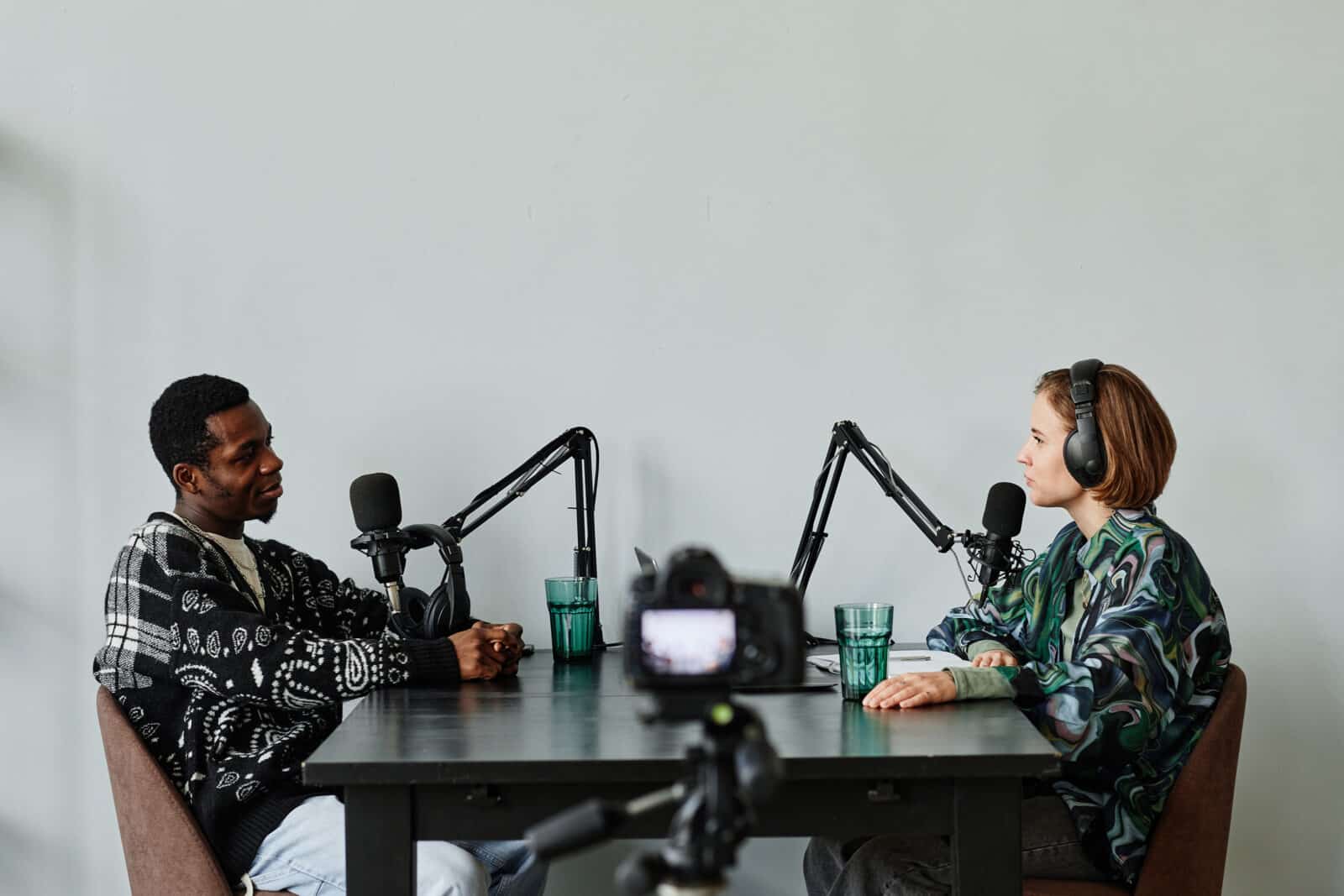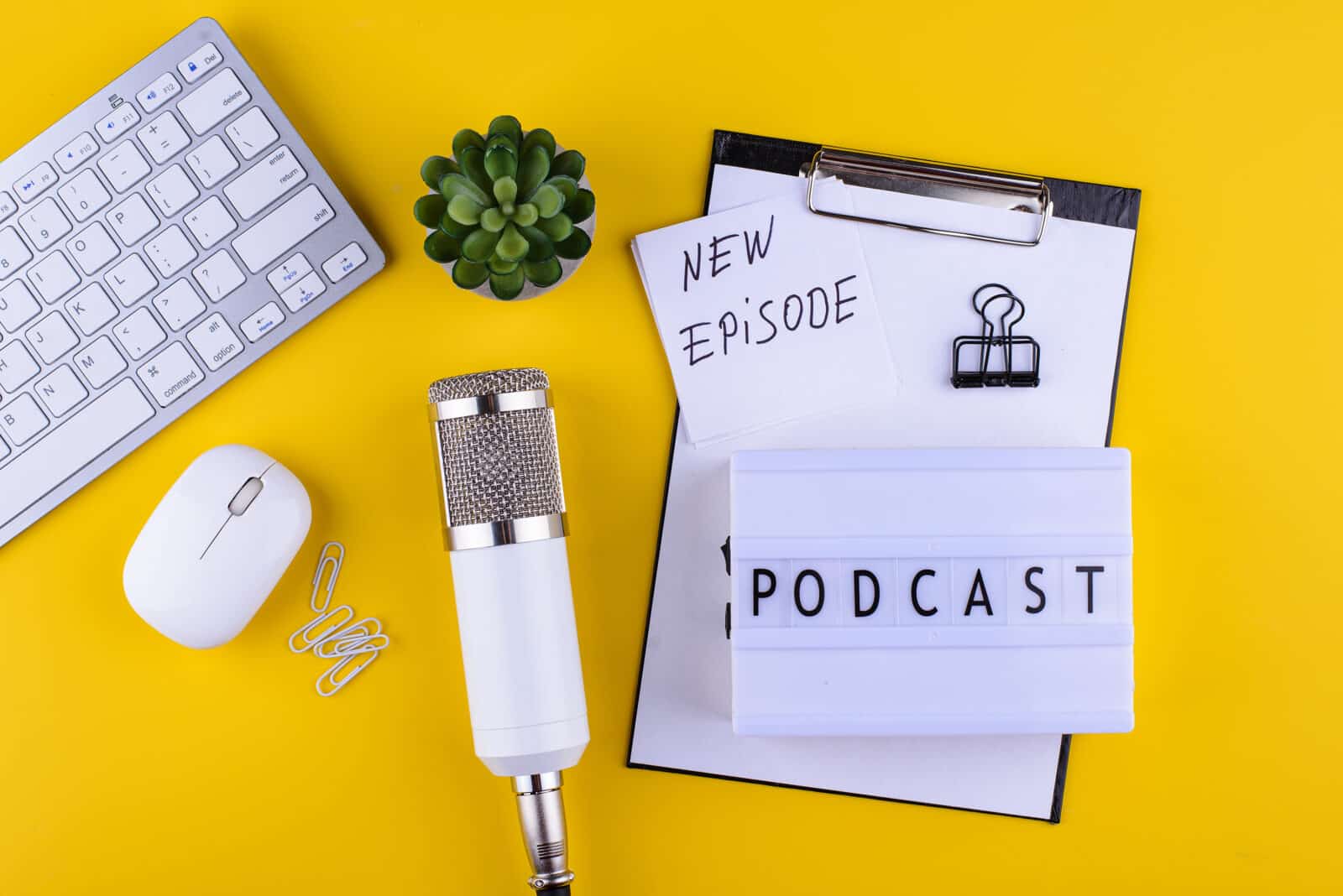
As a marketeting major and and a podcast enthusiast, I like to look at the ways that podcasts can be improved and how you can better get your message out to the world.
In this article, I’ll guide you through the maze of podcast structure, offering practical advice, tried-and-tested templates, and personal insights on crafting a podcast that resonates and engages. From nailing your intro to choosing the perfect soundtrack with Epidemic Sound, we’ll cover it all.
Understanding Podcast Structure
As someone who’s been immersed in the world of podcasting for years, I’ve learned that understanding and mastering your podcast’s structure is vital. Think of your podcast as a story or a journey you’re taking your listeners on. It should have a clear beginning, middle, and end, each playing a crucial role in keeping your audience engaged.

The beginning of your podcast is where you set the stage. This is where you introduce yourself, your topic, and what listeners can expect from the episode. It’s your chance to hook your audience with something intriguing, whether it’s an interesting fact, a provocative question, or a brief preview of the episode’s content. Remember, first impressions matter, and in podcasting, your introduction is that first impression.
The middle is the heart of your podcast. Here, you delve into the main content, whether it’s a narrative, an interview, or a discussion. This segment is where you deliver on the promises made in your introduction. It’s crucial to keep the content engaging, informative, and relevant. I always advise fellow podcasters to stay focused on their topic and ensure that every piece of content adds value to their listener’s experience.
Finally, the end of your podcast should provide closure. It’s not just about concluding the episode’s topic, but also about leaving your listeners with something to ponder, or better yet, a reason to return for your next episode. This could be a summary of key points, a teaser for the next episode, or a call to action, like encouraging listeners to subscribe or leave feedback.
Each of these segments plays a unique role in the overall experience you’re creating for your audience. When these elements come together harmoniously, you craft not just a podcast, but an experience that listeners will come back to time and again. Remember, a well-structured podcast is like a well-told story — it captivates, educates, and leaves the audience wanting more.
Incorporating Storytelling Techniques
Storytelling is a tool that transforms your podcast from a mere sequence of words into an immersive experience. Storytelling is not just about telling a story; it’s about connecting with your audience on a deeper level.

Firstly, understand the essence of your story. Every episode should have a central theme or message. Ask yourself, what’s the core idea you want to convey? Whether you’re sharing personal experiences, discussing a topic, or interviewing a guest, the narrative should revolve around this central theme.
Next, structure your story. Like classic storytelling, your podcast should have a beginning, middle, and end. Start with an introduction that sets the scene and piques interest. This could be a question, a surprising fact, or a brief anecdote that relates to your main topic. The middle is where the bulk of your content lies. Here, develop your narrative with details, arguments, or discussions that engage and inform your audience. Conclude with a resolution that ties back to your introduction, offering a sense of closure and reflection.
Use descriptive language to create vivid imagery. The beauty of podcasts lies in their auditory nature, so paint pictures with your words. Let your listeners visualize the scenes or concepts you’re discussing. This doesn’t mean overloading with adjectives, but choosing your words carefully to evoke the right emotions and images.
Embrace the power of your voice. Your voice is a potent storytelling tool – use it to convey emotions, emphasize points, and connect with your audience. Changes in tone, pace, and volume can all contribute to the storytelling experience.

Lastly, remember to be authentic. Authenticity resonates with listeners. Share your personal experiences, thoughts, and emotions where relevant. When your audience feels your sincerity, they’re more likely to engage with your podcast on a deeper level.
Incorporating these storytelling techniques can significantly enhance your podcast’s appeal. It’s not just about what you say, but how you say it. A well-told story can captivate your audience, making your podcast not just heard, but felt and remembered.
Planning Your Episodes

In my experience, one of the most critical steps in podcasting is planning your episodes. This stage is where you lay the groundwork for successful, engaging content. Here’s how I approach it:
-
Determine the Episode Length
The length of your episodes should align with the content and your audience’s expectations. For beginners, I recommend starting with shorter episodes, around 15-20 minutes, as they are less daunting for both the podcaster and the listener. As you gain more experience and understand your audience better, you can adjust the length. Consistency in episode length is key – your audience should know what to expect.
-
Balance Information Delivery and Pacing
Your episode should be a well-balanced mix of information and entertainment. It’s important not to overwhelm your listeners with too much information at once. Break down complex topics into digestible segments. Pacing is crucial; too fast, and you risk losing your audience, too slow, and they might get bored. Try to find a rhythm that feels natural and keeps the content flowing.
-
Scripting for Coherence
Whether to script your episode in detail or work from an outline depends on your style. I prefer using a detailed outline, which includes key points, questions for interviews, and any important facts or figures. This ensures I cover everything I intend to without sounding too scripted. If you’re someone who’s more comfortable with a full script, go for it, but strive to maintain a conversational and natural tone.
-
Incorporate Variety
To keep your audience engaged, mix up the format of your episodes. This could mean alternating between solo episodes and interviews or throwing in a Q&A session now and then. Variety keeps your content fresh and exciting.
-
Plan for Guest Interviews
If your episode includes interviewing a guest, preparation is crucial. Research your guest thoroughly and prepare questions that lead to insightful and engaging conversations. Always have more questions than you think you’ll need, as this allows for flexibility during the conversation.
-
Include Segments for Listener Engagement
Engaging with your audience is vital for building a community around your podcast. Include segments where you answer listener questions, share feedback, or discuss comments. This interaction makes your listeners feel valued and part of your podcast.
Remember, the way you plan your episodes can make or break your podcast. It’s about finding the right balance between structure and creativity to keep your content engaging and enjoyable.
Engaging Your Audience

Engaging your audience is the lifeblood of a successful podcast. Over the years, I’ve found that creating a connection with listeners is not just about producing great content, but also about fostering a sense of community and interaction. Here’s how I approach audience engagement:
-
Create Interactive Segments
Incorporate segments in your podcast that directly involve your audience. This could be a Q&A session where you answer questions sent in by listeners, or a ‘listener spotlight’ segment where you share stories or comments from your audience. These segments make listeners feel like an active part of your podcast, fostering a deeper connection.
-
Utilize Social Media
Social media is a powerful tool for engaging with your audience outside of the podcast itself. Share behind-the-scenes content, post episode teasers, and engage in conversations with your listeners. Use platforms like Twitter, Instagram, or Facebook to create a community around your podcast.
-
Encourage Listener Feedback
At the end of each episode, encourage your listeners to leave reviews or send feedback. Not only does this provide valuable insights for you as a podcaster, but it also gives your audience a voice. Recognize and appreciate feedback on your show, whether it’s through social media shoutouts or in your episodes.
-
Host Live Events or Q&A Sessions
Occasionally, hosting live events or Q&A sessions can significantly boost engagement. Live podcast recordings, webinars, or online meet-and-greets allow for real-time interaction, making your audience feel more connected to you and the podcast.
-
Personalize Your Content
Tailor your content to resonate with your audience. This could mean addressing topics that your listeners are interested in, or even personalizing content based on listener suggestions. When your audience feels that the content speaks directly to them, engagement levels soar.
-
Consistency is Key
Consistency in releasing episodes not only helps in building a routine for your listeners but also establishes reliability. Your audience should know when to expect new content from you.
Engaging your audience is about building a relationship. It’s about creating an interactive and inclusive environment where listeners don’t just consume your content but also contribute to it. The more you engage with your audience, the more invested they become in your podcast.
Choosing the Best Music and Sounds

Selecting the right music and sound effects is a crucial aspect of podcasting that often goes overlooked. It’s not just about filling silence; it’s about enhancing the mood, emphasizing key moments, and creating a signature sound for your podcast. Here’s how I approach this important aspect:
-
Setting the Tone with Theme Music
Your theme music sets the tone for your entire podcast. It’s the first thing listeners hear, so it should reflect the mood and style of your show. Whether you’re aiming for something upbeat and energetic or calm and contemplative, your theme music should align with your podcast’s identity.
-
Using Music to Enhance Emotions
Background music can be used to underscore key moments in your narrative, enhancing the emotional impact of your story. For instance, a light, whimsical tune can add humor to a funny anecdote, while a somber melody can deepen the impact of a serious topic. Be mindful of the volume and positioning of background music to ensure it supports, rather than distracts from, your content.
-
Transitioning with Sound Effects
Sound effects are excellent for signaling transitions, like moving from one segment to another or introducing a new theme. They help maintain the flow of your podcast and can keep your audience engaged through auditory cues.
-
Where to Find Music and Sounds
In the realm of podcasting, the significance of music and sound cannot be overstated. This is where Epidemic Sound shines as an invaluable resource. With its vast library of restriction-free music and sound effects, Epidemic Sound caters to every imaginable mood and theme for your podcast. Whether you need an upbeat tune to set the tone of your show or subtle sound effects to enhance your storytelling, Epidemic Sound offers a diverse range to choose from. This versatility is a game-changer, especially for podcasters looking to create a unique auditory identity for their shows.
Epidemic Sound offers a vast library of restriction-free music and sound effects, which is a goldmine for podcasters. You can find tracks and effects for almost any mood or segment in your podcast, and the best part is, they’re all legal to use.
Navigating the complex world of music rights can be daunting. Epidemic Sound simplifies this with its restriction-free model, ensuring that you can use any track or effect without worrying about copyright infringement. This peace of mind allows you to focus on what you do best – creating compelling podcast content. With a user-friendly interface and affordable subscription plans, Epidemic Sound is an excellent tool for both budding and seasoned podcasters aiming to enhance their audio experience.
-
Creating a Sonic Brand
Your music and sound choices contribute to your podcast’s sonic branding. Consistently using the same intro music, transition sounds, and even the style of background music can help create a recognizable and memorable audio brand for your show.
The music and sounds you choose play a significant role in defining the character of your podcast. They can enhance the listening experience, add professionalism to your production, and help your podcast stand out in a crowded field.
Consistency and Branding

In my podcasting journey, I’ve learned that consistency and branding are key pillars in building a successful podcast. They are what set you apart in a crowded market and help you build a loyal listener base. Here’s my approach to ensuring consistency and effective branding in your podcast:
-
Consistency in Release Schedule
One of the most important aspects of podcasting is having a regular release schedule. Your listeners should know when to expect new content from you. Whether it’s weekly, bi-weekly, or monthly, stick to a schedule. This consistency helps in building a habit for your audience and ensures they keep coming back for more.
-
Maintaining Consistent Quality
The quality of your episodes should be consistent. This includes the audio quality, content quality, and the overall production. Listeners should know that they can expect the same level of quality in each episode, which builds trust and reliability.
-
Branding Your Podcast
Your podcast’s branding encompasses everything from the podcast name, logo, and cover art to the tone of your content and the style of your presentation. Your brand should reflect the essence of your podcast and be appealing to your target audience. Strong, recognizable branding makes your podcast memorable and helps in growing your audience.
-
Consistent Audio Branding
This includes the consistent use of intro and outro music, as well as any recurring sound effects or jingles. These audio elements become a part of your brand identity. Regular listeners will immediately recognize your podcast just by hearing these elements.
-
Voice and Tone Consistency
The way you speak and the tone of your podcast should be consistent across episodes. This doesn’t mean you can’t have episodes that are more serious or more light-hearted than usual, but there should be a consistent underlying tone that your listeners can identify with your brand.
-
Social Media Branding
Your social media platforms should reflect the branding of your podcast. Use consistent graphics, colors, and tone in your posts. Social media is an extension of your podcast and plays a vital role in building and engaging with your community.
-
Audience Feedback for Improvement
Consistency doesn’t mean being inflexible. Listen to your audience’s feedback and be willing to make improvements. This shows that you value your audience’s opinion and are committed to providing them with the best listening experience.
Remember, consistency in podcasting is not just about releasing episodes on a regular schedule; it’s about creating a brand experience that your audience can rely on and enjoy with each episode. This consistency is what will help you grow your podcast over time.
Practical Examples and Templates

In my years as a podcaster, I’ve found that learning from practical examples and using templates can be incredibly helpful, especially for beginners. To give you a head start, let’s dive into some examples and templates that can serve as a guide for structuring your podcast episodes.
-
Solo Podcast Template
- Introduction – Start with a catchy hook, introduce yourself, and give a brief overview of the episode’s topic.
- Main Content – Divide your topic into subtopics. Discuss each subtopic thoroughly, providing insights, personal anecdotes, or relevant data.
- Conclusion – Summarize the key points. End with a call-to-action, such as encouraging listeners to subscribe or follow you on social media.
- Example – In an episode about time management, start with a surprising fact about productivity, delve into different time management techniques, and conclude with your personal recommendation and a prompt for listener feedback.
-
Interview Podcast Template
- Introduction – Briefly introduce the topic and your guest.
- Interview – Start with background questions, move to the main discussion, and end with some lighter, more personal questions.
- Conclusion – Thank your guest, summarize key takeaways, and end with a call-to-action.
- Example – For an interview with a nutrition expert, begin with their journey in nutrition science, discuss current dietary trends, and conclude with their day-to-day healthy eating tips.
-
Co-Hosted Podcast Template
- Introduction – Both hosts introduce themselves and briefly discuss the episode’s topic.
- Discussion – Alternate between hosts for different viewpoints or segments. Include friendly banter to keep it engaging.
- Conclusion – Both hosts share final thoughts and a call-to-action.
- Example – In a movie review podcast, one host could discuss the technical aspects of the film, while the other focuses on storytelling and performances, followed by a joint rating of the film.
-
Storytelling Podcast Template
- Introduction – Set the scene and introduce the story’s premise.
- Narration – Progress through the story, ensuring a clear narrative flow with climaxes and resolutions.
- Conclusion – Reflect on the story’s moral or message and end with a call-to-action.
- Example – For a historical podcast, start with the context of the event, narrate the key moments and their implications, and conclude with its impact on modern times.
These templates are starting points. The beauty of podcasting is in the flexibility and creativity it allows. Feel free to experiment and adapt these structures to suit your style and audience. Remember, the best podcasts reflect the unique personality and approach of their creators.
Conclusion
As we wrap up this journey through the nuances of podcasting, I hope you’ve gained valuable insights and practical tools to elevate your podcasting journey. Remember, at the heart of every successful podcast is a well-thought-out structure, a consistent brand, and an engaged audience. Whether you’re crafting your first episode or fine-tuning your hundredth, the principles we’ve explored are the compass that will guide you towards creating content that resonates and endures.
Podcasting is not just about speaking into a microphone; it’s an art form. It’s about storytelling, sharing perspectives, and building connections. As you apply these guidelines, remember to infuse your unique voice and passion into every episode. Your authenticity is the magic ingredient that will captivate your audience.
And finally, don’t forget the power of music and sound in bringing your podcast to life. Platforms like Epidemic Sound are there to help you set the perfect tone for your show. Embrace these resources, and watch your podcast transform into an auditory experience that your listeners look forward to.

Chris
Chris is a marketing major with a strong background in small business and influencer branding. He applies his knowledge of content and promotional strategies to design actionable advice for new and intermediate streamers. When he’s not busy crunching analytics, he can be found in the salt pits of League of Legends.


